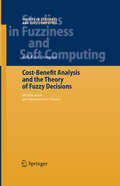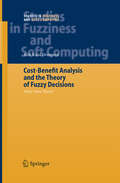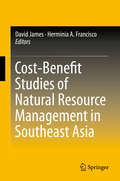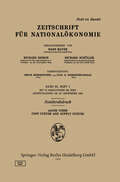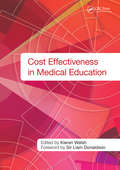- Table View
- List View
Cost-Benefit Analysis: Financial and Economic Appraisal Using Spreadsheets
by Harry F. Campbell Richard P.C. BrownNow in its third edition, Cost-Benefit Analysis has been updated, offering readers the perfect introduction to project, programme and policy appraisal using basic tools of financial and economic analysis. The key economic questions of any social cost-benefit analysis are: do the benefits of the project or policy exceed the costs, no matter how widely costs and benefits are spread, and irrespective of whether or not project impacts, such as environmental effects, are reflected in market prices? And which group or groups of individuals receive the benefits and which bear the costs? This book addresses these questions with an emphasis on putting the theory presented in the book into practice. This third edition has several attractive features: Readers are encouraged to develop their own skills by applying the tools and techniques of cost-benefit analysis to case studies and examples, including an analysis of a project which is developed throughout the book. The book emphasizes the use of spreadsheets which are invaluable in providing a framework for the cost-benefit analysis. A dedicated chapter provides guidance for writing up a report which summarises the analysis which has been undertaken. New pedagogical features, including Technical Notes and Examples, have been added as an aid to readers throughout the text. An appendix provides 14 additional case studies which can be developed in class or as assignment projects. Additional material for instructors and students is provided through Support Material maintained by Routledge. This updated edition is an ideal text for a course on cost-benefit analysis where the emphasis is on practical application of principles and equipping students to conduct appraisals. It is also a useful handbook for professionals looking for a logical framework in which to undertake their cost-benefit analysis work.
Cost-Benefit Analysis: Financial And Economic Appraisal Using Spreadsheets
by Harry F. Campbell Richard P.C. BrownA social cost-benefit analysis of a proposed publicly funded project, or public policy change, may be commissioned by a municipal, state or federal government, by a government aid agency, or by an international. Proponents of a private project which has significant social impacts may also commission an economic analysis of this type. The key economic questions of any social cost-benefit analysis are: do the benefits of the project exceed the costs, no matter how widely costs and benefits are spread? And which group or groups of individuals benefit and which bear the costs? This book addresses these questions with an emphasis on putting the theory into practice. The book has several unique features: readers are encouraged to develop their own skills by applying the tools and techniques of cost-benefit analysis to case studies including a project which is developed through the book; the use of spreadsheets is emphasised which is invaluable in allowing readers to test variables and cross-check the accuracy of their economic appraisal; and a dedicated chapter provides guidance on writing up a report which completes the analysis. An appendix lists additional case studies which can be developed in class or as additional projects. Each chapter contains exercises and suggestions for further reading. This book is an ideal text for a course on cost-benefit analysis where the emphasis is on practical applications and teaching students to conduct their own analysis.
Cost-Benefit Analysis: Financial And Economic Appraisal Using Spreadsheets
by Harry F. Campbell Richard P.C. BrownA social cost-benefit analysis of a proposed publicly funded project, or public policy change, may be commissioned by a municipal, state or federal government, by a government aid agency, or by an international. Proponents of a private project which has significant social impacts may also commission an economic analysis of this type. The key economic questions of any social cost-benefit analysis are: do the benefits of the project exceed the costs, no matter how widely costs and benefits are spread? And which group or groups of individuals benefit and which bear the costs? This book addresses these questions with an emphasis on putting the theory into practice. The book has several unique features: readers are encouraged to develop their own skills by applying the tools and techniques of cost-benefit analysis to case studies including a project which is developed through the book; the use of spreadsheets is emphasised which is invaluable in allowing readers to test variables and cross-check the accuracy of their economic appraisal; and a dedicated chapter provides guidance on writing up a report which completes the analysis. An appendix lists additional case studies which can be developed in class or as additional projects. Each chapter contains exercises and suggestions for further reading. This book is an ideal text for a course on cost-benefit analysis where the emphasis is on practical applications and teaching students to conduct their own analysis.
Cost-benefit Analysis: With Reference to Environment and Ecology
by James H. Meisel K. PuttaswamaiahThe world is increasingly concerned with bridging the developmental gap between the developed and developing countries. With the establishment of a number of institutions for funding the projects including the World Bank, Asian Development Bank, and many other agencies, the need to develop mechanisms to assess economically viable projects is more important than ever. The Social-Cost Benefit Analysis (SCBA) is an important technique used in formulating, appraising, and evaluating projects. It is a facet of applied welfare economics which is increasingly being used to identify and assess public projects in both developing and developed countries. This volume presents a comprehensive view of cost-benefit analysis in its theoretical and applied dimensions. Both theory and case studies are presented. The theoretical setting for Cost-Benefit Analysis is established by the first five chapters-"Spatial General Equilibrium and Cost-Benefit Analysis," by David M. Newbery; "Optimum Growth Theory and Social Time Preference: A Computerized Mathematical Modeling Exercise to Choose a Social Discount Rate," by Sardar M. N. Islam; "A Theoretical Inquiry of the Axiomatic Consistency of Distributional Weights used in Cost-Benefit Analysis," by Giuseppe Munda; "The Output Gap: Measurement, Related Concepts, and Policy Implications," by Parameswar Nandakumar; and "A Methodological Comparison of Theoretical Approaches in Dichotomous Choice Contingent Valuation," by John C. Whitehead. This book will be useful as a reference text by professors and students in project appraisal classes and will be of equal value to analysts, planners, and interested general readers.
Cost-benefit Analysis: With Reference to Environment and Ecology
by James H. Meisel K. PuttaswamaiahThe world is increasingly concerned with bridging the developmental gap between the developed and developing countries. With the establishment of a number of institutions for funding the projects including the World Bank, Asian Development Bank, and many other agencies, the need to develop mechanisms to assess economically viable projects is more important than ever. The Social-Cost Benefit Analysis (SCBA) is an important technique used in formulating, appraising, and evaluating projects. It is a facet of applied welfare economics which is increasingly being used to identify and assess public projects in both developing and developed countries. This volume presents a comprehensive view of cost-benefit analysis in its theoretical and applied dimensions. Both theory and case studies are presented. The theoretical setting for Cost-Benefit Analysis is established by the first five chapters-"Spatial General Equilibrium and Cost-Benefit Analysis," by David M. Newbery; "Optimum Growth Theory and Social Time Preference: A Computerized Mathematical Modeling Exercise to Choose a Social Discount Rate," by Sardar M. N. Islam; "A Theoretical Inquiry of the Axiomatic Consistency of Distributional Weights used in Cost-Benefit Analysis," by Giuseppe Munda; "The Output Gap: Measurement, Related Concepts, and Policy Implications," by Parameswar Nandakumar; and "A Methodological Comparison of Theoretical Approaches in Dichotomous Choice Contingent Valuation," by John C. Whitehead. This book will be useful as a reference text by professors and students in project appraisal classes and will be of equal value to analysts, planners, and interested general readers.
Cost-Benefit Analysis
by E. J. Mishan Euston QuahShould Malaysia build a new steel mill, or New York City an urban motorway? Should higher education expand, or water supplies be improved? These are typical questions to which cost-benefit analysis, the key economic tool for analyzing problems of social choice can contribute to, as well as providing a useful vehicle for understanding the practical value of welfare economics. This invaluable text covers the main problems that arise in a typical cost-benefit exercise. Cost-benefit analysis is used everywhere, but its techniques are particularly prominent in fields where there is some kind of ethical dimension. For this edition, E.J. Mishan has been joined by Euston Quah, to explore new themes, including the impact of uncertainty on cost-benefit analysis and to introduce a host of new and up-to-date case studies.
Cost-Benefit Analysis
by E. J. Mishan Euston QuahShould Malaysia build a new steel mill, or New York City an urban motorway? Should higher education expand, or water supplies be improved? These are typical questions to which cost-benefit analysis, the key economic tool for analyzing problems of social choice can contribute to, as well as providing a useful vehicle for understanding the practical value of welfare economics. This invaluable text covers the main problems that arise in a typical cost-benefit exercise. Cost-benefit analysis is used everywhere, but its techniques are particularly prominent in fields where there is some kind of ethical dimension. For this edition, E.J. Mishan has been joined by Euston Quah, to explore new themes, including the impact of uncertainty on cost-benefit analysis and to introduce a host of new and up-to-date case studies.
Cost-Benefit Analysis
by E.J. Mishan Euston QuahCost-benefit analysis (CBA) is the systematic and analytical process of comparing benefits and costs in evaluating the desirability of a project or programme – often of a social nature. It attempts to answer such questions as whether a proposed project is worthwhile, the optimal scale of a proposed project, and the relevant constraints. CBA is fundamental to government decision making and is established as a formal technique for making informed decisions on the use of society’s scarce resources. This timely 6th edition of the classic Cost-Benefit Analysis text continues to build on the successful approach of previous editions, with lucid explanation of key ideas, simple but effective expository short chapters, and an appendix on various useful statistical and mathematical concepts and derivatives. The book examines important developments in the discipline, with relevant examples and illustrations as well as new and expanded chapters which build upon standard materials on CBA. Highlights include; updated historical background of CBA extended non-market goods valuation methods the impact of uncertainty evaluation of programmes and services behavioural economics decision rules and heuristics CBA and regulatory reforms CBA in developed and developing countries value of household production other topics frequently encountered in CBA, such as costs of diseases and air pollution, and value of statistical life This book is a valuable source and guide to international funding agencies, governments, interested professional economists and senior undergraduate and graduate students. The text is fully supported by a companion website, which includes discussion questions and PowerPoint slides for each chapter.
Cost-Benefit Analysis
by E.J. Mishan Euston QuahCost-benefit analysis (CBA) is the systematic and analytical process of comparing benefits and costs in evaluating the desirability of a project or programme – often of a social nature. It attempts to answer such questions as whether a proposed project is worthwhile, the optimal scale of a proposed project, and the relevant constraints. CBA is fundamental to government decision making and is established as a formal technique for making informed decisions on the use of society’s scarce resources. This timely 6th edition of the classic Cost-Benefit Analysis text continues to build on the successful approach of previous editions, with lucid explanation of key ideas, simple but effective expository short chapters, and an appendix on various useful statistical and mathematical concepts and derivatives. The book examines important developments in the discipline, with relevant examples and illustrations as well as new and expanded chapters which build upon standard materials on CBA. Highlights include; updated historical background of CBA extended non-market goods valuation methods the impact of uncertainty evaluation of programmes and services behavioural economics decision rules and heuristics CBA and regulatory reforms CBA in developed and developing countries value of household production other topics frequently encountered in CBA, such as costs of diseases and air pollution, and value of statistical life This book is a valuable source and guide to international funding agencies, governments, interested professional economists and senior undergraduate and graduate students. The text is fully supported by a companion website, which includes discussion questions and PowerPoint slides for each chapter.
Cost-Benefit Analysis: Cases and Materials
by Euston Quah Raymond TohCost-benefit analysis (CBA) is the systematic and analytical process of comparing benefits and costs in evaluating the desirability of a project or programme, often of a social nature and for society as a whole. CBA is fundamental to government decision-making and can be an effective tool for informed decisions on the use of society's scarce resources. This book highlights the main concepts and principles of cost-benefit analysis used in real life cases and actual applications. The book contains rich cases, materials and examples of real life CBA applications with emphasis both on physical and non-physical projects and infrastructure developments in Asia and beyond. The book also discusses techniques frequently used in applied CBA. The first part of the book introduces the key concepts and principles of CBA before Part Two covers some pertinent issues relating to CBA, such as the recent trend of using behavioural economics and frequently used techniques in applied CBA. Finally, in Part Three, case studies are written up to illustrate how CBA is done, and questions for the readers and students to ponder are raised at the end of each chapter. The scope of the case studies is more than just physical infrastructures but will include public sector policies and programmes covering a host of social policies as in health, education, social welfare programmes, and the environment. For each case, there will be illustrations of the key concepts and principles of CBA used. Undertakings analyzed include: the Three Gorges Dam in China the 2008 Beijing Olympics the Costs of Global Warming the Jamuna Bridge in Bangladesh The case studies, many of which have taken or are to take place in developing countries provide a rich background to the principles of the method, and are accompanied by a wealth of explanatory material. As well as being suitable for courses in Cost-Benefit Analysis, Public Finance, Environmental and Health Economics, the book should be of interest to all public policy decision makers and planners.
Cost-Benefit Analysis: Cases and Materials
by Euston Quah Raymond TohCost-benefit analysis (CBA) is the systematic and analytical process of comparing benefits and costs in evaluating the desirability of a project or programme, often of a social nature and for society as a whole. CBA is fundamental to government decision-making and can be an effective tool for informed decisions on the use of society's scarce resources. This book highlights the main concepts and principles of cost-benefit analysis used in real life cases and actual applications. The book contains rich cases, materials and examples of real life CBA applications with emphasis both on physical and non-physical projects and infrastructure developments in Asia and beyond. The book also discusses techniques frequently used in applied CBA. The first part of the book introduces the key concepts and principles of CBA before Part Two covers some pertinent issues relating to CBA, such as the recent trend of using behavioural economics and frequently used techniques in applied CBA. Finally, in Part Three, case studies are written up to illustrate how CBA is done, and questions for the readers and students to ponder are raised at the end of each chapter. The scope of the case studies is more than just physical infrastructures but will include public sector policies and programmes covering a host of social policies as in health, education, social welfare programmes, and the environment. For each case, there will be illustrations of the key concepts and principles of CBA used. Undertakings analyzed include: the Three Gorges Dam in China the 2008 Beijing Olympics the Costs of Global Warming the Jamuna Bridge in Bangladesh The case studies, many of which have taken or are to take place in developing countries provide a rich background to the principles of the method, and are accompanied by a wealth of explanatory material. As well as being suitable for courses in Cost-Benefit Analysis, Public Finance, Environmental and Health Economics, the book should be of interest to all public policy decision makers and planners.
Cost-Benefit Analysis and Dementia: New Interventions
by Robert J. BrentThis ground-breaking book expertly brings together the many effective dementia interventions to reduce the symptoms of this debilitating condition and also, for the first time, a Cost-Benefit Analysis of those interventions to establish whether the benefits outweigh the costs. Focussing on new interventions such as years of education, medicare eligibility, hearing aids and vision correction, Robert Brent also takes an innovative look at the need to reduce elder abuse and initiate an international convention for human rights. Cost-Benefit Analysis and Dementia takes an insightful look at dementia by using a behavioural definition and explaining how the symptoms can affect daily life activities, rather than just using the medical definition. It examines the causality of dementia interventions to establish their effectiveness, dealing with the risk factors and expanding the current list of interventions. Furthermore, it provides an in-depth three-step procedure for evaluating the monetary benefits of those interventions to establish whether these are found to be socially worthwhile. Written in a comprehensive, yet accessible style, this book will be an excellent resource for economists interested in the Cost-Benefit Analysis of dementia care. Healthcare professionals and policymakers as well as non-professionals will find the different interventions discussed to reduce symptoms of dementia illuminating and informative.
Cost-Benefit Analysis and Public Policy (Journal of Policy Analysis and Management Classics #1)
by David WeimerThis volume seeks to facilitate such exposure by drawing together into a convenient collection the fine articles on CBA and its application that have appeared in the Journal of Policy Analysis and Management (JPAM).
Cost-Benefit Analysis and the Theory of Fuzzy Decisions: Identification and Measurement Theory (Studies in Fuzziness and Soft Computing #158)
by Kofi Kissi DompereThe genus of definitions for the theoretical sciences is (the province of) the habitus of the intellective intention, for the practical sciences, however, that of the effective intention; the objects and ends constitute the specific differ ence There is nothing in the intellect that has not already been in the senses, that is, in the sensory organs, that has not already been in sensible things from which are distinguished things not perceptible to the senses. Nothing can be of the mind, sensation and the thing inferred therefrom except the operation itself. Real learning is cognition of things in themselves. It thus has the basis of its certainty in the known thing. This is established in two ways: by demon stration in the case of contemplative things, and by induction in the case of things perceptible to the senses. In contrast with real learning there is pos sible, probable and fictive learning. Antonius Gvilielmus Amo Afer (1827) This research has been long in the making. Its conception began in my last years in the doctoral program at Temple University, Philadelphia, Pa. It was simultaneously conceived with my two books on the Neo Keynesian Theory of Optimal aggregate investment and output dynamics [201] [202] as well as reflections on the methodology of decision-choice rationality and development economics [440] [441]. Economic theories and social policies were viewed to have, among other things, one impor tant thing in common in that they relate to decision making under different.
Cost-Benefit Analysis and the Theory of Fuzzy Decisions: Fuzzy Value Theory (Studies in Fuzziness and Soft Computing #160)
by Kofi Kissi DompereCriticism is the habitus of the contemplative intellect, whereby we try to recognize with probability the genuine quality of a l- erary work by using appropriate aids and rules. In so doing, c- tain general and particular points must be considered. The art of interpretation or hermeneutics is the habitus of the contemplative intellect of probing into the sense of somewhat special text by using logical rules and suitable means. Note : Hermeneutics differs from criticism as the part does from the whole. Antonius Gvilielmus Amo Afer (1727) There is no such thing as absolute truth. At best it is a subj- tive criterion, but one based upon valuation. Unfortunately, too many people place their fate in the hands of subjective without properly evaluating it. Arnold A. Kaufmann and Madan M. Gupta The development of cost benefit analysis and the theory of fuzzy decision was divided into two inter-dependent structures of identification and measurement theory on one hand and fuzzy value theory one the other. Each of them has sub-theories that constitute a complete logical system.
Cost-Benefit Analysis of Environmental Goods by Applying Contingent Valuation Method: Some Japanese Case Studies
by Uddin Sarwar Ahmed Keinosuke GotohContingent valuation is one of the means of incorporating socio-environmental considerations in cost–benefit analysis. The authors of this book have examined environmental valuation methods through the lens of cost–benefit analysis focused on three case studies in Japan: public parks, a bay wetland, and a recreational theme park. With implications for the world at large, the findings presented here serve as a valuable source of information on Japanese behavior regarding the valuation of environmental goods. New, alternative approaches and guidelines for cost–benefit analysis in the public and private spheres also are discussed. This volume makes an important addition to the library of all researchers and other scientists in the fields of environmental science and environmental economics.
Cost-Benefit Studies of Natural Resource Management in Southeast Asia
by David James Herminia A. FranciscoThis book applies cost-benefit analysis techniques in the management of environment and natural resources in developing countries of the Southeast Asian region and presents a compendium of studies conducted by researchers supported by the Economy and Environment Program for Southeast Asia (EEPSEA). It emphasizes the close relationship between the environment and natural resources and economic development in such countries, addressing a wide range of problems that can be understood using economic evaluation techniques. General guidelines for conducting economic appraisals are provided, with the case studies illustrating how they can be applied in a developing country context. Cost-Benefit Analysis Application in Environmental and Natural Resource Management in Southeast Asia serves as essential reading for teachers, researchers, students and practitioners in environmental and natural resource economics, economic development and key issues facing policymakers in the Southeast Asian region.
Cost Curves and Supply Curves (Journal of Economics Zeitschrift für Nationalökonomie Supplementum)
by Jacob VinerCost-Effective Pension Planning: Work in America Institute Studies in Productivity: Highlights of The Literature
by Robert L. ClarkCost-Effective Pension Planning
Cost Effectiveness in Medical Education
by Kieran WalshWith economic winter facing many healthcare and health education budgets, the high costs of medical education are bringing it under close scrutiny. However, the costs of not providing high quality medical education - not least human costs in morbidity and mortality from medical error - are also high, presenting medical educators, funding managers, policy makers and economists with an unenviable dilemma. To add to their difficulties, remarkably little has been written on cost effectiveness in medical education, including how to calculate costs, how to get maximal value for money and even what constitutes value for money. In this book, the first of its kind, world leading experts comprehensively outline what is known about cost effectiveness in each of their fields. Undergraduate, postgraduate and continuing professional education are all explored, as are e-learning, simulation, cost benefit analysis and numerous other areas. Lecturers and researchers in medical education, clinical tutors and educational supervisors and appraisers, managers responsible for funding medical education and health economists and health policy makers and shapers will find this an invaluable resource. 'An excellent analysis and explanation of an under-explored subject' - from the Foreword by Sir Liam Donaldson.
Cost Effectiveness in Medical Education
by Kieran WalshWith economic winter facing many healthcare and health education budgets, the high costs of medical education are bringing it under close scrutiny. However, the costs of not providing high quality medical education - not least human costs in morbidity and mortality from medical error - are also high, presenting medical educators, funding managers, policy makers and economists with an unenviable dilemma. To add to their difficulties, remarkably little has been written on cost effectiveness in medical education, including how to calculate costs, how to get maximal value for money and even what constitutes value for money. In this book, the first of its kind, world leading experts comprehensively outline what is known about cost effectiveness in each of their fields. Undergraduate, postgraduate and continuing professional education are all explored, as are e-learning, simulation, cost benefit analysis and numerous other areas. Lecturers and researchers in medical education, clinical tutors and educational supervisors and appraisers, managers responsible for funding medical education and health economists and health policy makers and shapers will find this an invaluable resource. 'An excellent analysis and explanation of an under-explored subject' - from the Foreword by Sir Liam Donaldson.
Cost Effectiveness Modelling for Health Technology Assessment: A Practical Course
by Richard Edlin Christopher McCabe Claire Hulme Peter Hall Judy WrightThis book provides an introduction to decision analytic cost-effectiveness modelling, giving the theoretical and practical knowledge required to design and implement analyses that meet the methodological standards of health technology assessment organisations. The book guides you through building a decision tree and Markov model and, importantly, shows how the results of cost-effectiveness analyses are interpreted.Given the complex nature of cost-effectiveness modelling and the often unfamiliar language that runs alongside it, we wanted to make this book as accessible as possible whilst still providing a comprehensive, in-depth, practical guide that reflects the state of the art – that includes the most recent developments in cost-effectiveness modelling. Although the nature of cost effectiveness modelling means that some parts are inevitably quite technical, across the 13 chapters we have broken down explanations of theory and methods into bite-sized pieces that you can work through at your own pace; we have provided explanations of terms and methods as we use them. Importantly, the exercises and online workbooks allow you to test your skills and understanding as you go along.











